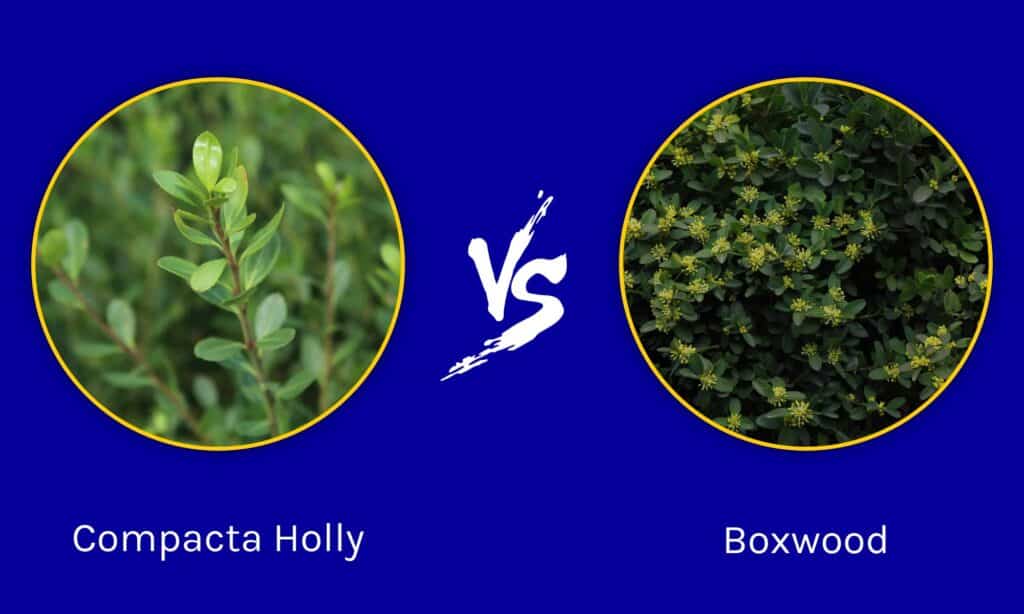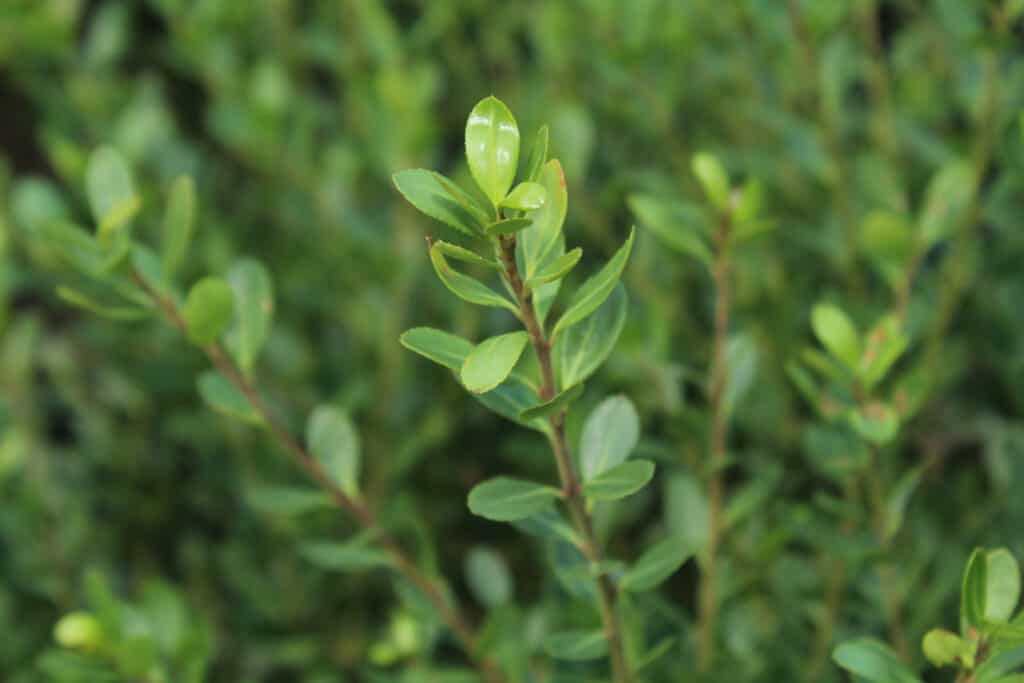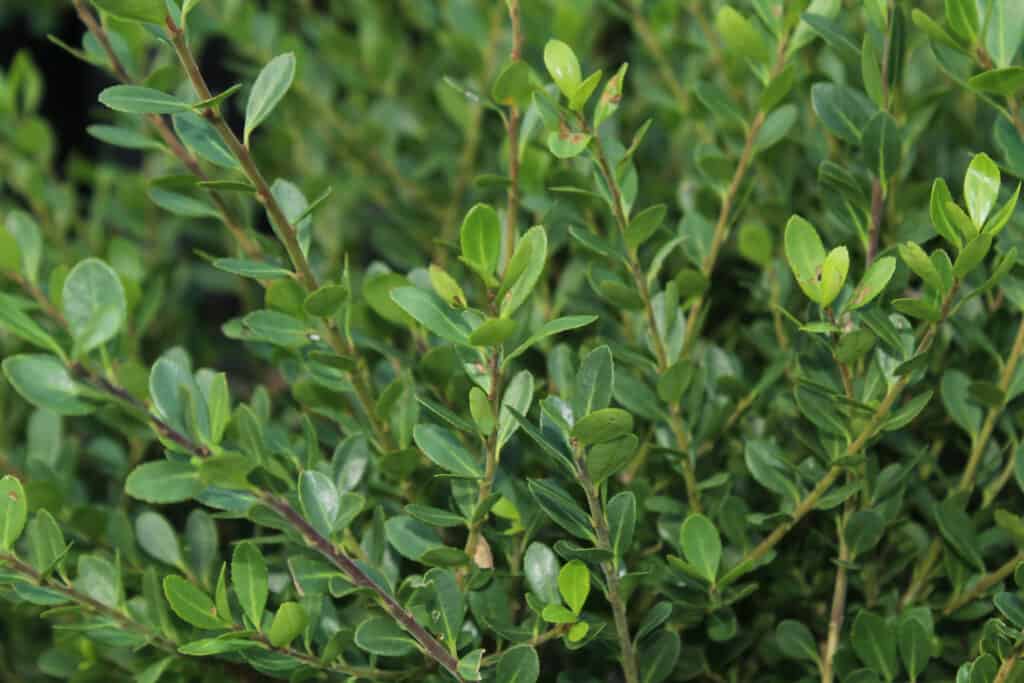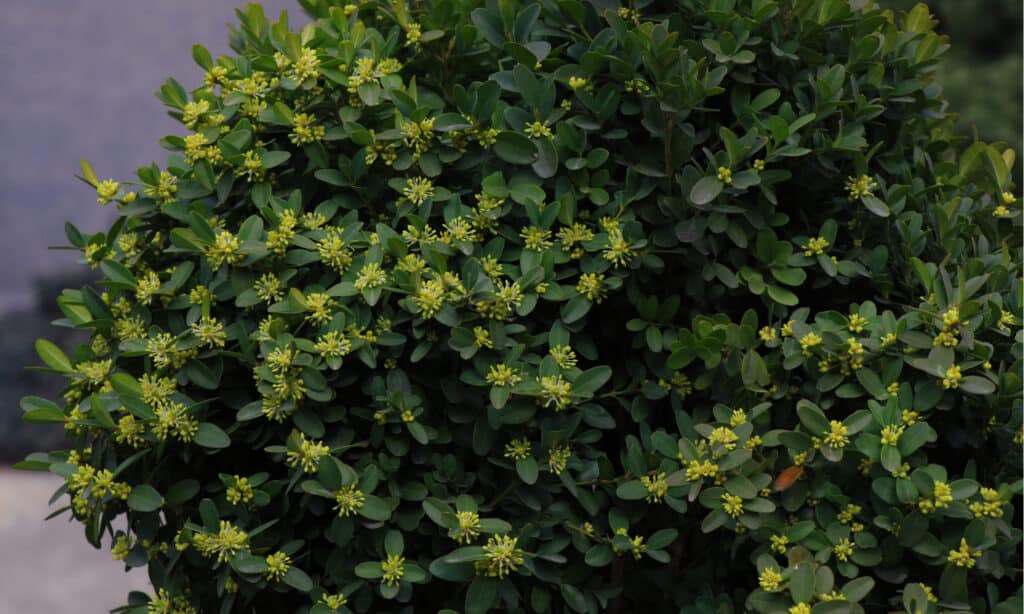Compacta holly and boxwood are two types of flowering plants resembling each other. One of the easiest ways to distinguish them is by their leaf arrangement, which is alternate for compacta holly and opposite for boxwood. However, diving deep into their classifications, origins, and uses, we’ll notice many other methods to distinguish the two.
The most important distinction between these two plants is that compacta holly is a species. At the same time, the term “boxwood” stands for a whole genus that comprises approximately 70 species native to various places on Earth.
Let’s learn how to differentiate compacta holly from boxwood!
Comparing Compacta Holly vs. Boxwood

| Compacta Holly | Boxwood | |
|---|---|---|
| Classification | Kingdom: Plantae Clade: Tracheophytes Clade: Angiosperms Clade: Eudicots Clade: Asterids Order: Aquifoliales Family: Aquifoliaceae Genus: Ilex Species: Ilex crenata | Kingdom: Plantae Clade: Tracheophytes Clade: Angiosperms Clade: Eudicots Order: Buxales Family: Buxaceae Genus: Buxus |
| Plant Type | Evergreen shrub or small tree; dioecious plant | Evergreen shrub or small tree; monoecious plant |
| Origin | Eastern China, Japan, Taiwan, Korea, and Sakhalin | Southern Europe, Africa, southwestern, southern, and eastern Asia, Madagascar, northern South America, Mexico, Central America, and the Caribbean |
| Description | – Height: 9.8 – 16.4 feet – Trunk diameter: 7.9 inches – Alternate, glossy dark green, leaves measuring 0.3 – 1.2 inches long and 0.3 – 0.6 inches broad; – White flowers with four petals; black drupe as fruit having four seeds and measuring 0.2 inches in diameter | – Height: 6.5 – 39.3 feet – Opposite, leathery, rounded to lanceolate leaves measuring 0.6 – 2 inches long and 0.1 – 1 inches broad; – Small yellow-green flowers; small capsule fruit measuring 0.2 – 0.6 inches long and having several seeds |
| Uses | Hedging, edging, foundation planting, cottage gardens, city gardens | Hedges, wood carving, decorative or storage boxes, chess pieces, stringed instruments, recorders |
| Selected Cultivars | Golden Gem, Ivory Hall, Green Island, Fastigiata | Green Velvet, Winter Gem |
The Key Differences between Compacta Holly and Boxwood
If you’re planning to get one of the two as an ornamental plant for your garden, you’re probably wondering which one will suit your garden best. We’re here to discuss four key differences between compacta holly and boxwood.
We’ll start with their scientific classification because it’s extremely important to know that there are numerous boxwood species you can choose from. Then, we’ll move on to what kind of plants they are, which will help you further investigate how to grow and take care of each.
Compacta holly and boxwood also have different appearances, with one growing taller than the other, which is another essential factor to consider. We’ll also discuss their uses worldwide. This adds great value to their beautiful appearance.
Compacta Holly vs. Boxwood: Classification

Compacta holly is the common name for the
Ilex crenataspecies.
©iStock.com/keepphotos
The first and most important distinction between compacta holly and boxwood is their scientific classification. Let’s discuss each to understand where they stand regarding families and species.
Compacta holly is the common name for the Ilex crenata species. It is also called Japanese holly or box-leaved holly. It’s a species in the Ilex genus, part of the Aquifoliaceae family. This genus consists of over 570 flowering plant species.
On the other hand, boxwood is the common name for the Buxus genus, which is part of the Buxaceae family of flowering plants. When we’re using the term “boxwood,” we may be referring to any of the roughly 70 species in this genus.
The Buxus genus is split into three sections based on genetic distinctions and species regions:
- The Eurasian group includes 28 species, among which Buxus balearica, Buxus colchica, Buxus hyrcana, Buxus microphylla, and Buxus sempervirens
- The African and Madagascan group 16 species, among which Buxus hildebrandtii, Buxus macowanii, Buxus nyasica, and Buxus obtusifolia
- The American group includes 20 species, including Buxus arborea, Buxus citrifolia, and Buxus vahlii.
Compacta Holly vs. Boxwood: Plant Type

Compacta holly is a dioecious shrub.
©iStock.com/keepphotos
Both compacta holly and boxwood are flowering plants. They are either evergreen shrubs or evergreen trees. What distinguishes them is their reproductive system. Compacta holly is a dioecious shrub, while boxwood is a monoecious shrub (or tree). So what does this mean?
These terms are used to refer to plant reproduction. Dioecious plants have either a female or a male flower. Female compacta holly shrubs require the presence of a male plant in order to be pollinated. To distinguish male plants from female plants, check if they have stamens loaded with pollen. If you spot these, your plant is male.
By contrast, monoecious plants have male and female flowers on the same plant and do not need other individuals to pollinate.
Compacta Holly vs. Boxwood: Description

The flowering plants in the
Buxusgenus have opposite leaves with a leathery structure.
©Antoniya Kadiyska/Shutterstock.com
If we consider the average plant height, boxwood shrubs and trees are larger than compacta holly plants, as they can grow as tall as 39.3 feet, some specimens reaching almost 50 feet in height! By contrast, compacta holly shrubs and trees only grow up to 16.4 feet tall. Rare specimens reached 32 feet tall.
Compacta holly has glossy dark green leaves with an alternate leaf arrangement. Its leaves measure 0.3 – 1.2 inches long and 0.3 – 0.6 inches wide. Its flowers are white and have four petals. Compacta holly fruits are called drupes and are black in color. They measure 0.2 inches in diameter and have four seeds.
Boxwood leaves are roughly the same size, measuring 0.6 – 2 inches long and 0.1 – 1 inches broad, depending on the species. However, a boxwood species called Buxus macrocarpa has unusually large leaves – they can reach 4.33 inches long and 2 inches wide, approximately thrice the size of compacta holly or other boxwood leaves.
The flowering plants in the Buxus genus have opposite leaves with a leathery structure. The leaves are rounded to lanceolate. These plants have small yellow-green flowers. Their fruits measure approximately 0.2 – 0.6 inches long and have several seeds. Buxus macrocarpa fruits can reach 1.2 inches long.
Compacta Holly vs. Boxwood: Uses
Both compacta holly and boxwood are used in cottage and city gardens for hedging, edging, and foundation planting. Some studies point to the medicinal use of Ilex crenata, while boxwood species were and still are widely used for decorative and storage purposes.
While there’s no specific official information regarding Ilex crenata, hollies are generally used as sources of beverages and medicines, ornamental plants, and honey plants. Holly leaf infusions are produced and consumed in the United States, South America, and China. Tea infusions are made either from one or more Ilex species. A study shows that Ilex species can be used to protect the cardiovascular system, enhance anti-tumor, anti-oxidant, and anti-inflammatory activity, and encourage anti-obesity and anti-diabetic activity.
Ilex crenata is extremely popular as an ornamental plant thanks to its beautiful appearance.
Buxus species have been used in wood carving for decorative or storage boxes, chess pieces, musical instruments, and recorders. They’ve been historically used in various fields, from engineering to arts. Their wood served as scale and technical drawing ruler material. Other things made from boxwood include set squares, yardsticks, slide rules, protractors, combs, and weaving shuttles.
Up Next:
Thank you for reading! Have some feedback for us? Contact the AZ Animals editorial team.








